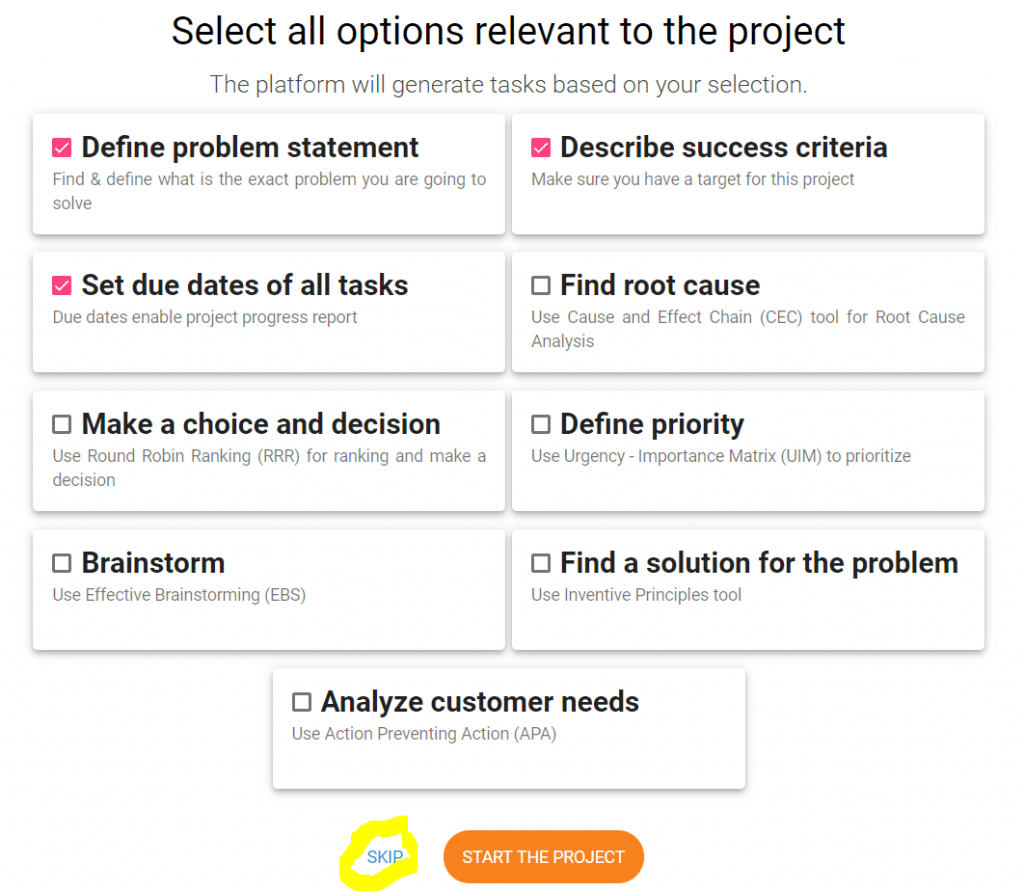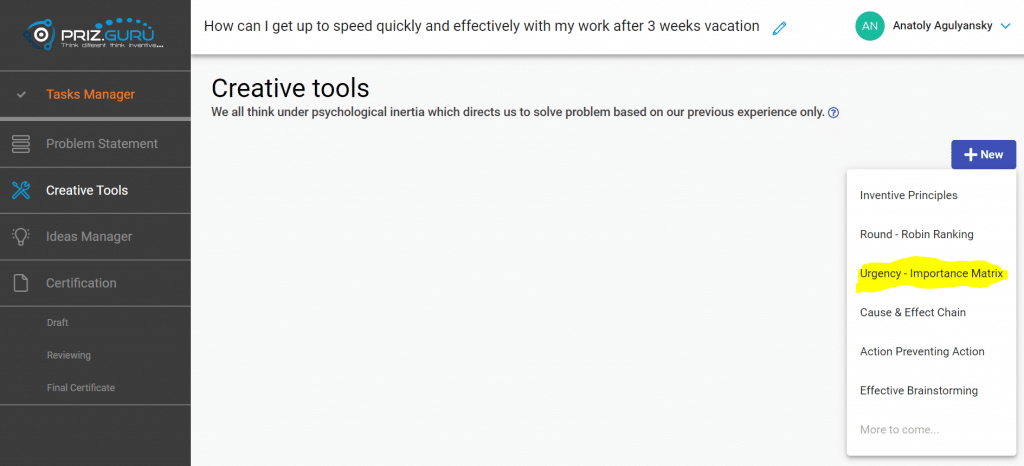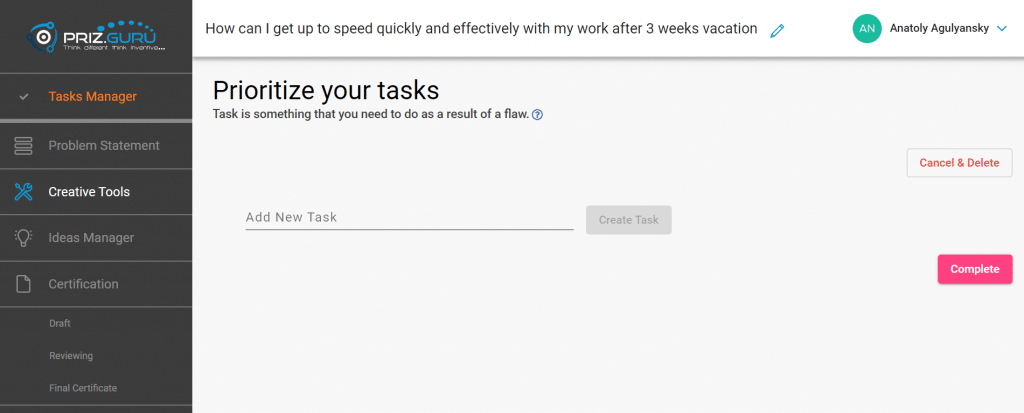My wife and I like to travel and we travel a lot. Recently we spent three weeks in China, but when the vacation was over, we had to return to work.
I came to my workplace, entered my cubicle, and, as on any other day, opened the laptop and connected to the company’s systems. Pretty quickly I realized that those three weeks are too short for vacation but very long to be disconnected from work. Many things happened, and I needed to make up the leeway to get up to speed with everything that had happened and related to my duties at work. It is clear that a huge amount of tasks should be completed in a short time. I need task prioritization.
Are there any recommendations on how can we get up to speed effectively and quickly at the same time? How can we get all the necessary and relevant information and avoid wasting time on irrelevant data? How to manage task priority? This is a serious problem. Therefore, inventive thinking tools should be used.
Let’s analyze what I have and what I need.

There are several sources of information that I can use to get up to speed with my work:
Emails – I’ve got over 1000 new unread emails. These also include invitations to the past meetings that I was not able to attend and to the new ones which are scheduled for the nearest future.
Manager – I can get an update from my manager, but I need to be very specific in my questions because my manager has very limited time for a conversation.
Peers – I can get an update from my peers.
Subordinates – I can get an update from my subordinates.
Recurring meetings – I can get an update by participating in the regular recurring meeting.
One-off & New meetings – I can get an update by participating in newly initiated meetings
These are the things that I need to know to be confident that I am fully up to speed:
Strategy changes updates are there any changes in the strategy related to my work that occurred during my vacation?
Excursions updates – any information on safety or quality events related to my work that happened while I was away.
Projects’ progress updates – everything related to the main blockers of my projects’ progress, and any information on the current status of the projects.
The time is extremely important. I need to get up to speed as soon as possible to be able to start operating quickly and effectively. To achieve my goals, I need to invest time in the most relevant tasks and not waste time on irrelevant and not important tasks. I need an instrument for task priority management.
What does it mean?
It means that I need to create a list of tasks and prioritize them. I need to use the tool for task priority management. I need an instrument that will help me to achieve more with less by spending less time.
I used one of the inventive thinking tools provided in PRIZ Guru Platform. The tool is called Urgency – Importance Matrix (UIM) which is the most effective for task prioritization, especially when used together with Round Robin Ranking (RRR).
I want to start with the final result. We’ll dive into the process right after.
The final result of the prioritized tasks is shown below:

The Urgency – Importance Matrix tool separated all my tasks in four groups: “Do First”, “Do Later”, “Delegate” and “Drop”. This is the first step of the prioritization. This is prioritization in groups.
As one can see, a meeting is preferable to reading an email or any other written information.
What I should not do to avoid time wasting?
As a result, clearly indicates, I should DELEGATE or DROP tasks.
It is important to mention that the order of tasks is only important within the two groups that I need to worry about: “Do First” & “Do Later”.
I should not worry about the sequence of tasks that I need to “Delegate” or “Drop”.
Each group contains a number of tasks that should be also prioritized within the group.
The second step of the prioritization is ranking (priority definition) within a group is completed with the Round – Robin Ranking tool that is associated with the Urgency-Importance Matrix tool in the PRIZ Guru Platform.
Please have a look again at the resulting table shown above and you will see that the tasks of the first two groups “Do First” and “Do Later” are also prioritized and mentioned in order from high priority to low priority within each group.
How did I do it? How did I manage my tasks in the most effective way?
I used Urgency – Importance Matrix in conjunction with the Round Robin Ranking tool.
Let’s dive into the details of task priority management and walk through this example step by step using PRIZ Guru Platform.
1. Sign up or sign in if you already have an account
Please read about registration. The account is needed to keep the information available to you and only you.
2. Click on “New Project” and provide a title for your project
Try to create a meaningful title, so it will be easier to find later. An example is shown below:

3. Skip the wizard of the project tasks in the case of tasks priority management

It would be useful to fill in the Project Details, but this step is not mandatory for tasks priority management
By clicking “Skip” you will be navigated directly to the Creative Tools page
4. Start with Urgency – Importance Matrix (prioritization in groups)
Navigate to the “Creative Tools” page by clicking “Next” on the project details. Click “+New” and select Urgency – Importance Matrix. Once the tool is ready, you will be redirected to a dedicated UIM page.

5. Add all the tasks you need to prioritize
Write down (or copy/paste) the task and click “Create Task”.

Here is my list of tasks that we need to prioritize:
6. Assign Urgency and Importance for each task using trivial rules
a. The urgency is a function of the expectation
As I already covered this topic in detail in another article, the urgency depends on how expected or unexpected the flaw you are planning to address is.
The unexpected flaw needs to be addressed with High Urgency, while the expected one can be dealt with with Low Urgency.
An example is shown below:

b. The importance is the function of the cost
Similar to urgency, I am referring to the cost of a flaw that you are planning to address.
The high cost of the flaw corresponds to the High Importance task, while Low Cost corresponds to Low Importance. An example is shown below:

7. Automatically group the tasks

Once we finished assigning urgency and importance, the system can automatically prioritize the tasks in groups. To do that, click “Complete” at the bottom of the list. The result is shown below:
8. Rank the tasks within the first two groups (Prioritization within the group)
The first result of UIM is a grouping of tasks into 4 categories. The last two categories contain tasks that we don’t really need to worry about, PRIZ Platform allows ranking of the tasks falling under “Do First” and “Do Later”.
To rank the tasks in each group, using Round Robin Ranking, click “Rank Tasks” for each group and rank the tasks as shown below:

9. Final results
One task ranking in both groups is completed. the final result will be shown on the result page on UIM as shown below:

Now we have complete prioritization of tasks. We made a decision on how to proceed, how to make more by doing less.
The prioritization with our tool saves your time and increases the efficiency of your work or any activity.
Good luck!
Start doing more with less time.
Improve your efficiency, and become more productive with less effort.
Excel and stand out at work and your projects!
Visit the PRIZ Guru site https://www.priz.guru/ to read more about tasks priority and use “Online Platform” https://app.priz.guru/ to prioritize your tasks.
Do not hesitate to contact us if you have any questions or need assistance.
LOGIN to PRIZ Innovation Platform and start your project.